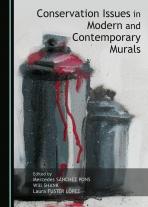Book Review: Conservation Issues in Modern and Contemporary Murals
Submitted by Kate Smith on

Review by Dr. Zsuzsanna Wierdl
"Conservation Issues in Modern and Contemporary Murals"
Edited by Mercedes Sánchez Pons, Will Shank, Laura Fuster López,
New Castle upon Tyne, UK, Cambridge Scholars Publishing 2015
English and Spanish / $107.95 / Hardcover
ISBN-13: 9781443872331
First of all I would like to thank the editors for this precious volume. It is a great pleasure to review "Conservation Issues in Modern and Contemporary Murals," edited by Mercedes Sanchez Pons, Will Shank and Laura Fuster Lopez. This book is the resulting publication from “Modern and Contemporary Mural Painting: Conservation Treatment and Access” (MCMP2012), a conference held in Valencia, Spain, at the Polytechnic University in May 2012. This specific forum among conservators, conservation scientists, artists and heritage managers was organized, supported, and funded by the Getty Conservation Institute in Los Angeles and the Conservation and Restoration of Cultural Heritage department of the Universidad Politécnica de Valencia.
It is an unusual and special opportunity for the artists and creators themselves to participate in a forum on mural painting conservation. Generally in the field of conservation only conservators, scientists, architects, and art historians are present at such meetings. But in the case of modern and contemporary murals, scientists and restorers are not limited to studying an artist's techniques centuries after the artwork was created or re-discovering the lost mysteries of a masterpiece; rather they can discuss the technical problems with the artists themselves. This is a unique experience not only for conservation professionals, but also for the creators themselves. In cases where the artist can be consulted, the mural painting conservator does not have to make an educated guess, like the traditional conservator of, say, a Botticelli mural: “Oh Sandro, you should not have used cinnabar on the wall; did you know that?“ Those who work with contemporary murals can consult with the artists themselves. And vice versa, before creating a mural, the artist can consult with the conservator for the latest thinking on the most appropriate and lasting pigments and materials.
The book includes the voices of the many different stakeholders involved in the complex task of preserving artworks: the vital experiences of artists who create murals and are sometimes asked to treat their creations; theoretical reflections on how to deal methodologically with conservation; scientific studies on the identification of constituent materials and the development of procedures for their preservation; the specific experiences of conservators; and the opinions of cultural managers.
This book mirrors the structure of the conference, consisting of three sections:
SECTION 1: MODERN AND CONTEMPORARY MURAL PAINTINGS: CONCEPT, MATERIALS AND VALUE
This section includes an interesting case study of the Berlin Wall, the preservation and techniques of contemporary outdoors murals, identification and characterization of materials, graffiti murals, and vandalism.
SECTION 2: INNOVATIONS IN THE TREATMENT OF MODERN AND CONTEMPORARY MURALS: DEVELOPMENT OF NEW MATERIALS AND METHODS
Chapters twelve through twenty-four provide information on how to clean and protect acrylic paintings and outdoor murals, the latest research into protective and anti-graffiti coatings, and retouching materials. Also included are unique examples such as the treatment of a Keith Haring mural in Pisa, Italy.
SECTION 3: SUSTAINABLE MANAGEMENT OF MODERN AND CONTEMPORARY MURALISM: SOCIETY’S ROLE AND HERITAGE ACTIVISM
This section addresses questions such as, “Can artists and conservators collaborate to make their works last as long possible?” “Do we know exactly what materials artists use in their production?” “Why do these materials often age so quickly?” “What role do artists play in their preservation?” “Is repainting a valid alternative?” “Who is responsible for the conservation of ‘community murals’?“
While we may not yet have satisfactory answers to such questions, we must continue to discuss them, and this volume lends an important and significant voice in the difficult task of preserving murals, helping us to work toward answers. Congratulations to all of the contributors for their important work and again to the editors who gave us this very interesting and special volume.
AUTHOR BYLINE
Dr. Zsuzsanna Wierdl is a specialist in mural painting conservation and architecture sciences. She holds a doctorate in architecture and is the recipient of the Mihály Munkácsy Prize, awarded for recognition of outstanding contributions in fine arts in Hungary. She was the leading conservator of the Royal Chapel in Esztergom. She has also worked as the main restorer of the Santo Stefano Rotondo, the Basilica dedicated as Hungary’s national church in Rome. Dr. Wierdl is also the lead researcher and restorer on the Roman Borromini Loggia and is Chair of the ICOMOS Mural Painting International Scientific Committee.